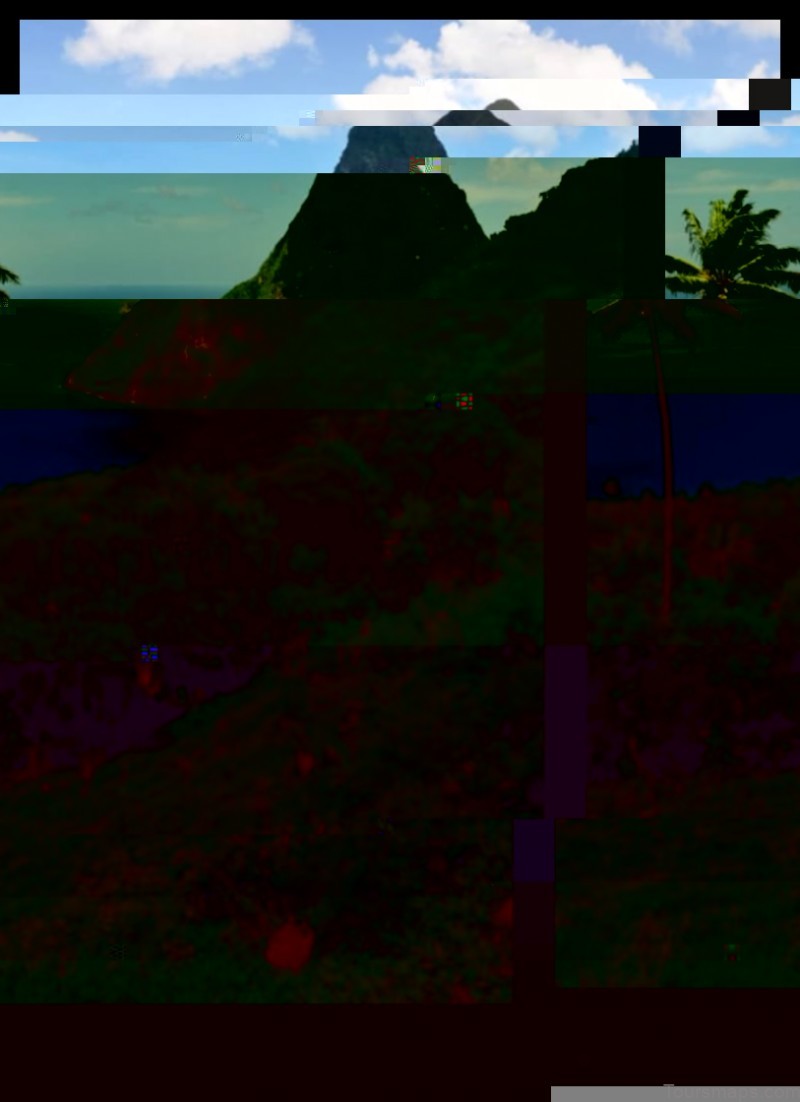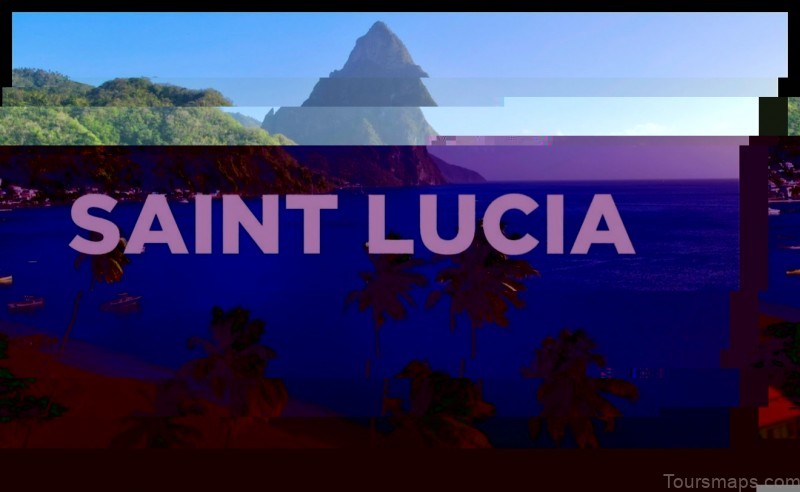
I. Introduction
Saint Lucia is a Caribbean island nation located in the Lesser Antilles. It is bordered by Martinique to the north and Barbados to the east. The island has a population of approximately 180,000 people and a land area of 616 square kilometers.

II. Saint Lucia’s Geography
Saint Lucia is a mountainous island with a coastline of approximately 150 kilometers. The highest point on the island is Mount Gimie, which is 950 meters tall. The island is also home to a number of rivers, lakes, and waterfalls.
Saint Lucia’s Climate
Saint Lucia has a tropical climate with a warm, humid climate year-round. The average temperature is 27 degrees Celsius, with highs of 32 degrees Celsius and lows of 22 degrees Celsius. The island receives an average of 2,000 millimeters of rainfall per year.
Saint Lucia’s Culture
Saint Lucia’s culture is a blend of African, European, and Creole influences. The island’s official languages are English and French Creole. The majority of the population is Christian, with a small minority of Muslims and Hindus.
Saint Lucia’s Economy
Saint Lucia’s economy is based on tourism, agriculture, and manufacturing. The island is a popular tourist destination due to its beautiful beaches, lush rainforests, and friendly people. The main agricultural products are bananas, cocoa, and sugarcane. The main manufactured goods are rum, furniture, and clothing.
Saint Lucia’s Government
Saint Lucia is a parliamentary democracy with a governor-general as head of state. The prime minister is the head of government. The legislature is bicameral, consisting of the House of Assembly and the Senate.
Saint Lucia was first inhabited by the Arawak people around 2,000 years ago. The island was later colonized by the Spanish, the French, and the British. Saint Lucia gained independence from the United Kingdom in 1979.
Saint Lucia is a popular tourist destination due to its beautiful beaches, lush rainforests, and friendly people. The island has a number of hotels, resorts, and guesthouses to choose from. There are also a number of activities to enjoy, such as swimming, snorkeling, diving, hiking, and fishing.
The population of Saint Lucia is approximately 180,000 people. The majority of the population is of African descent, with a small minority of Europeans, Asians, and Caribs. The official languages are English and French Creole.
Q: What is the capital of Saint Lucia?
A: The capital of Saint Lucia is Castries.
Q: What is the currency of Saint Lucia?
A: The currency of Saint Lucia is the Eastern Caribbean dollar.
Q: What is the time zone of Saint Lucia?
A: The time zone of Saint Lucia is Atlantic Standard Time (AST).
Q: What is the national dish of Saint Lucia?
A: The national dish of Saint Lucia is green fig and saltfish.
| Topic | Answer |
|---|---|
| Map of Saint Lucia | |
| Saint Lucia map | Saint Lucia is a Caribbean island located in the Lesser Antilles. It is about 240 km (150 mi) south of Martinique and 300 km (190 mi) north of Barbados. The island has a total area of 616 km2 (238 sq mi) and a population of about 180,000 people. |
| Saint Lucia geography | Saint Lucia is a mountainous island with a coastline of about 150 km (93 mi). The highest point on the island is Mount Gimie, which is 950 m (3,117 ft) high. The island is also home to a number of rainforests and waterfalls. |
| Saint Lucia map and flag | |
| Saint Lucia tourism features | Saint Lucia is a popular tourist destination due to its beautiful beaches, lush rainforests, and friendly people. The island is also home to a number of historical and cultural attractions, such as the Pitons, the Soufriere Volcano, and the Fort Charlotte. |
II. Saint Lucia’s Geography
Saint Lucia is a Caribbean island located in the Lesser Antilles. It is about 240 km (150 mi) southeast of Martinique and about 300 km (190 mi) northwest of Barbados. The island has a total area of 616 km2 (238 sq mi), making it the second-largest island in the Windward Islands. Saint Lucia’s coastline is 158 km (98 mi) long and its highest point is Mount Gimie at 950 m (3,117 ft). The island has a tropical climate with a wet season from June to November and a dry season from December to May.

II. Saint Lucia’s Geography
Saint Lucia is a Caribbean island located in the Lesser Antilles. It is the second largest island in the Windward Islands, after Dominica. Saint Lucia has a total area of 616 square kilometers (238 square miles) and a population of approximately 180,000 people. The island is mountainous, with the highest point being Mount Gimie at 950 meters (3,117 feet). Saint Lucia’s climate is tropical, with average temperatures ranging from 25°C to 30°C (77°F to 86°F). The island receives an average of 2,000 millimeters (79 inches) of rainfall per year. Saint Lucia’s vegetation is lush and varied, and includes rainforests, mangrove swamps, and coral reefs. The island is home to a wide variety of plant and animal life, including the St. Lucia parrot, the St. Lucia wood dove, and the St. Lucia racer.
II. Saint Lucia’s Geography
Saint Lucia is a Caribbean island located in the Lesser Antilles. It is about 240 km (150 mi) southeast of Martinique and about 300 km (190 mi) northwest of Barbados. The island has a total area of 616 km2 (238 sq mi), and a population of about 180,000 people. Saint Lucia’s landscape is dominated by mountains, with the highest point being Mount Gimie at 950 m (3,117 ft). The island has a tropical climate, with average temperatures ranging from 25 °C (77 °F) to 30 °C (86 °F). The rainy season runs from June to November, and the dry season runs from December to May.
V. Saint Lucia’s Economy
Saint Lucia’s economy is based on tourism, agriculture, and financial services. The tourism industry is the largest contributor to the economy, accounting for over 60% of GDP. The main tourist attractions include the island’s beaches, rainforests, and historical sites. Agriculture is the second-largest contributor to the economy, accounting for about 20% of GDP. The main agricultural products include bananas, cocoa, and sugar. Financial services are the third-largest contributor to the economy, accounting for about 10% of GDP. The main financial services include banking and insurance.
VI. Saint Lucia’s Government
Saint Lucia is a parliamentary democracy with a Governor-General as head of state. The Governor-General is appointed by the Queen of England on the advice of the Prime Minister. The Prime Minister is the head of government and is appointed by the Governor-General. The Prime Minister is usually the leader of the party that wins the most seats in the House of Assembly. The House of Assembly is the lower house of Parliament and is made up of 17 members who are elected by the people of Saint Lucia. The Senate is the upper house of Parliament and is made up of 11 members who are appointed by the Governor-General.
The government of Saint Lucia is responsible for the day-to-day running of the country. It is also responsible for making laws and setting policies. The government works closely with the private sector to develop the economy and improve the lives of the people of Saint Lucia.
VII. Saint Lucia’s History
Saint Lucia’s history is a long and complex one, dating back to the arrival of the first humans on the island around 3,000 years ago. The island was first settled by the Arawaks, who were followed by the Caribs in the 14th century. In 1502, Christopher Columbus sighted the island and claimed it for Spain. However, the Spanish did not establish a permanent settlement on the island until the 17th century.
In 1650, the French took control of the island from the Spanish. The French ruled Saint Lucia for over a century, during which time the island became a major sugar producer. In 1763, the British took control of the island during the Seven Years’ War. The British ruled Saint Lucia for over a century, during which time the island was involved in several conflicts, including the American Revolution and the Napoleonic Wars.
In 1814, Saint Lucia was returned to French control. The French ruled the island for another 50 years, until it was ceded to the British in 1867. Saint Lucia remained a British colony until it gained independence in 1979.
Since independence, Saint Lucia has been a member of the Commonwealth of Nations and the Organisation of Eastern Caribbean States. The country has a parliamentary system of government, with a prime minister as head of government and a governor-general as head of state. Saint Lucia is a developing country with a strong tourism industry. The country’s economy is also based on agriculture, fishing, and manufacturing.
Saint Lucia’s Tourism
Saint Lucia is a popular tourist destination, with its stunning beaches, lush rainforests, and friendly people. The island offers a variety of activities for visitors, including hiking, swimming, snorkeling, diving, fishing, and golfing. There are also a number of historical and cultural sites to explore, such as the Fort Charlotte ruins and the Pitons, which are two volcanic peaks that rise steeply out of the sea.
The tourism industry is a major contributor to the Saint Lucian economy, and it is estimated that it generates around 20% of the island’s GDP. The industry employs a large number of people, and it also helps to promote Saint Lucia’s culture and heritage to the world.
Saint Lucia is a safe and welcoming destination for tourists, and it is easy to get around the island. There are a number of international airlines that fly to Saint Lucia, and there are also a number of ferries that connect the island to other Caribbean destinations.
If you are planning a trip to Saint Lucia, there are a few things you should know. First, the island is on the Atlantic Time Zone, so it is one hour ahead of New York City. Second, the official language of Saint Lucia is English, but many people also speak French Creole. Third, the currency of Saint Lucia is the Eastern Caribbean dollar (EC$).
Here are some tips for planning your trip to Saint Lucia:
- Book your flights and accommodations in advance, especially if you are traveling during peak season (December to April).
- Bring comfortable shoes, as you will be doing a lot of walking.
- Pack sunscreen, sunglasses, and a hat, as the sun can be strong in Saint Lucia.
- Bring a camera to capture the stunning scenery.
- Be prepared for rain, as it can rain at any time of year in Saint Lucia.
Saint Lucia is a beautiful and diverse island with something to offer everyone. Whether you are looking for a relaxing beach vacation or an exciting adventure, you are sure to find it in Saint Lucia.
IX. Saint Lucia’s People
The people of Saint Lucia are a diverse mix of cultures, with African, European, and East Indian influences. The official language of Saint Lucia is English, but a number of Creole languages are also spoken, including Saint Lucian Creole, which is a blend of English, French, and African languages.
The population of Saint Lucia is about 180,000 people, and the majority of people live in the coastal areas. The capital city of Saint Lucia is Castries, which is located on the northern coast of the island.
The people of Saint Lucia are known for their friendly and welcoming nature, and they are always happy to share their culture with visitors.
X. FAQ
Q: What is the capital of Saint Lucia?
A: Castries is the capital of Saint Lucia.
Q: What is the population of Saint Lucia?
A: The population of Saint Lucia is approximately 180,000 people.
Q: What is the official language of Saint Lucia?
A: The official language of Saint Lucia is English.
Table of Contents
Maybe You Like Them Too
- Explore Blavozy, France with this detailed map
- Explore East Lindfield, Australia with this detailed map
- Explore Bonferraro, Italy with this detailed map
- Explore Doncaster, United Kingdom with this detailed map
- Explore Arroyito, Argentina with this Detailed Map
